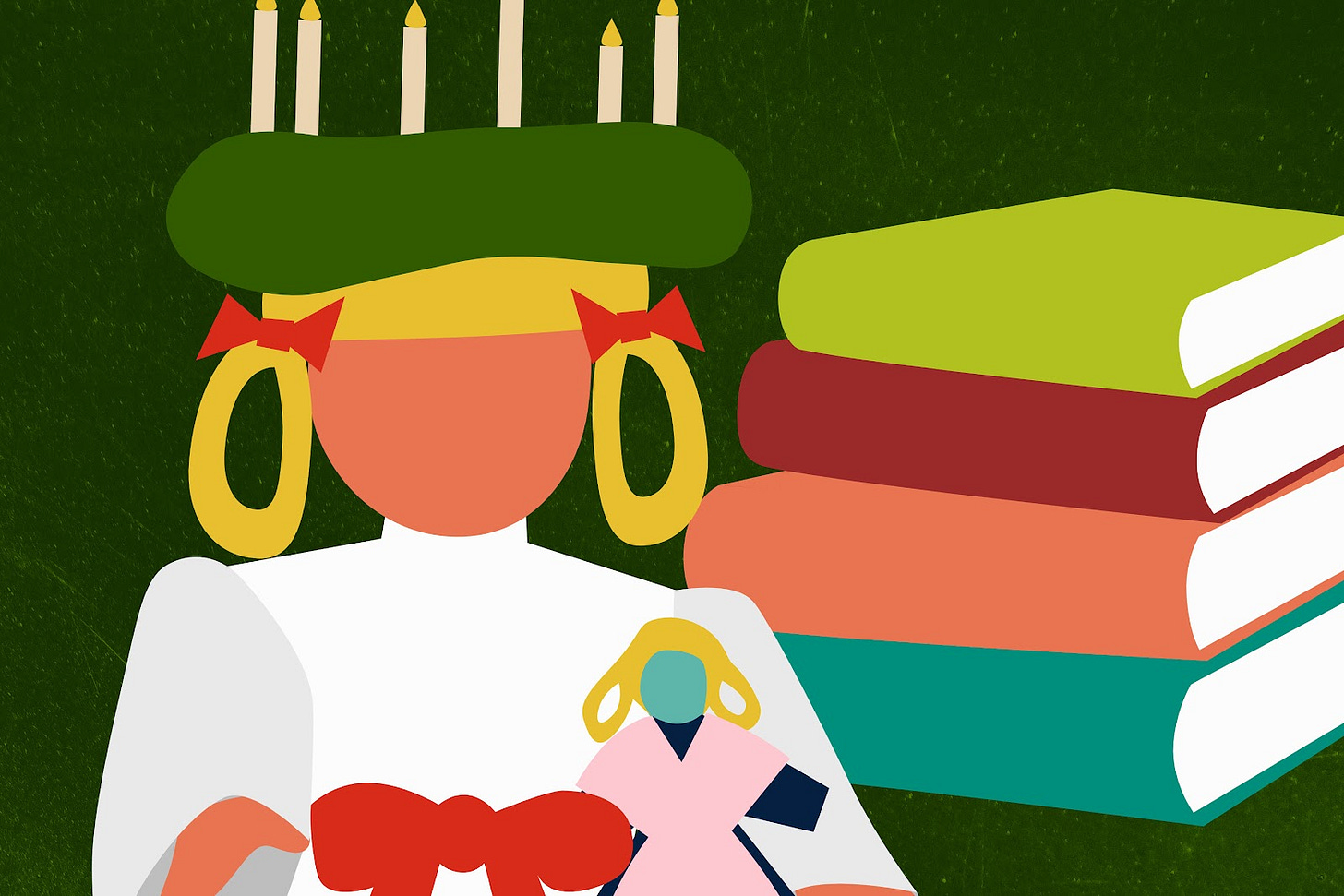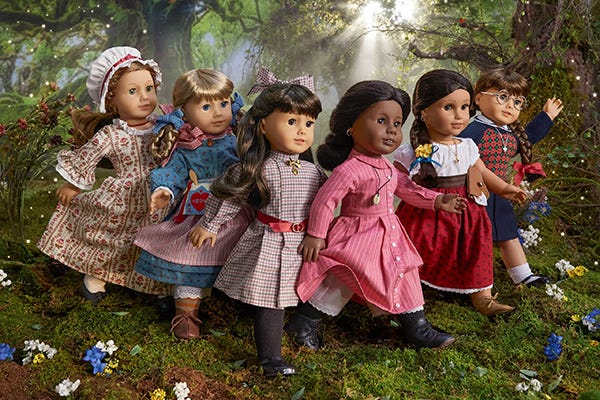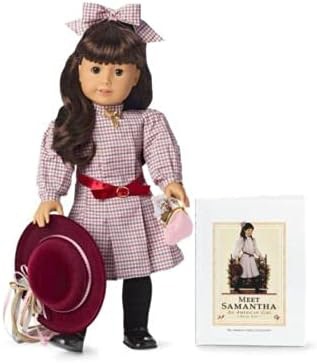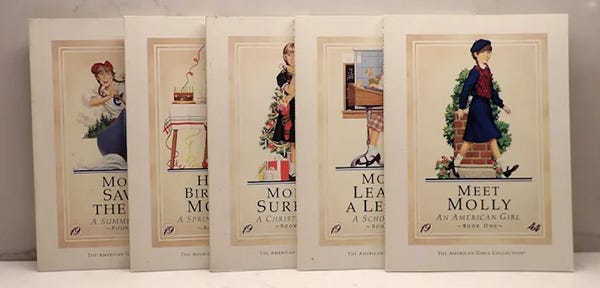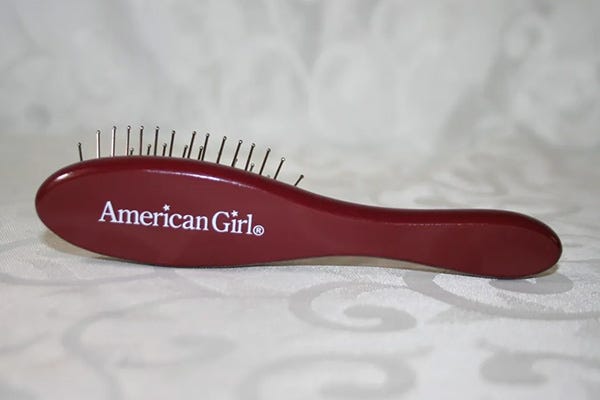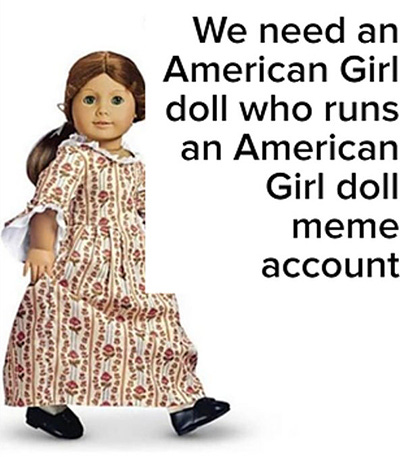Fandom, Femininity, and Friendship: The Cultural Impact of American Girl
Looking back on the original American Girl dolls and how they shaped a generation
If you’re a woman born sometime in the early to mid 80s, you may have had a Christmas like mine at the age of nine. For months, a mysterious catalog found its way to my home, which was really astute for late 80s marketing: how did this company know that the perfect customer for their products–me, again, nine years old –lived at my address? More so, how did they know that I would become so enthralled with their products that I would beg my parents to buy them for me, and pour over the catalogs with clean fingers and never bending the pages, as if they were rare books 📕?
The company of course was The Pleasant Company. The product: American Girl Dolls.
Once a niche set of dolls, toys and books that could only be ordered via catalog and therefore, a niche fandom, the company has grown exponentially. Their brick and mortar stores are a year-round destination for kids and their parents. Just try and get a reservation at their in-store café 🍰 during the holidays–I dare you. The fandom is as strong as ever. But it is separated into two, maybe three sections: the now-adult fans of the OG dolls of the late 80s, the fans of the later additional dolls to the line, and the enthusiasts who came to the brand after the 1998 Mattel sale of the company. More on that later.
In the late 80s, those catalogs started appearing in my mailbox and I kept a stack of them in a desk drawer where they wouldn’t get torn. There was one doll that I had become relatively obsessed with: Samantha Parkington, a brown-haired beauty with long locks and thick bangs, just like mine.
It’s no wonder I was so into her: the Pleasant Company catalog was a large squarish trim size with glossy photos and a to-scale centerfold photo of each doll. That meant if you turned the catalog sideways and opened to the page where a doll was featured, you could see how tall it really was. It was eye candy for my future fashion magazine-loving soul. These dolls were fancy: they looked well-made enough to collect and soft enough to play with and change their outfits easily. Their period costumes charmed me even though my personal style consisted of lots of neon and bike shorts and high top sneakers (much like my preteen peers in the late 80s).
In case you’re unfamiliar with the history of the company, it's as quaint as the founder’s name: news anchor/grade school teacher/textbook 👩🏫 author Pleasant T. Rowland founded the American Girl toy company in 1986 after an inspirational trip to Colonial Williamsburg in Virginia (relatable). Combining her love of American history, her wish to create aspirational dolls for girls, and interest in high quality toys and books, she developed the product line. It first consisted of three dolls and characters: Kirsten Larson, a Swedish immigrant pioneer girl from the mid-1800s; the aforementioned Samantha Parkington, a wealthy orphan from the Victorian era (depending on your opinion; technically the years Samantha’s stories take place in is Edwardian, but I’m not sure I cared about the historical accuracy at age nine); and Molly McIntire, a Scottish-American girl living in Illinois at the time of World War II. Later dolls added to the line would include Felicity Merriman from the Virginia Colony on the verge of Revolution, and Josefina Montoya, a Mexican girl living in New Mexico in 1815, just after Mexico’s independence from Spain (but before the United States’ possession of the territory). They also launched the Bitty Baby infant dolls line that featured lifelike baby dolls in several varieties. In 1995 the company eventually expanded to include Truly Me dolls, which could look like the child who would own it in accordance with skin, hair and eye color as well as accessories like glasses, and the Bitty Baby line reflected these varieties as well.
Every original American Girl doll came with a series of books 📚 written by a vast team of authors: Valerie Tripp, Susan S. Adler, Maxine Rose Schur, Janet Beeler Shaw and many more as the company expanded.
Each book focused on a different event in the girls’ lives: Christmas🎄 or winter ❄️ holidays, birthdays 🎂, school events, and other adventures. These books introduced real merch for purchase, like a Christmas dress and accessories for a holiday celebration or a school desk and books. The accessories were period- and culture-specific, which helped educate young girls about what school or celebrations might be like for a girl in that period of history and in their culture. There isn’t an adult fan of American Girl who didn’t learn about the Swedish St. Lucia’s Day holiday from Kirsten, who celebrates with her family wearing the traditional crown of candles on her head. And my mind was truly blown when I learned that Samantha Parkington, going to school in 1904, had to carry her books in a leather book strap, a Victorian era version of the backpack. But these accessories were not cheap: I remember memorizing the price tag on those little schoolbooks, and a quick internet search reminded me that they were, in fact, $18.
This is to say nothing of the dress-like-your-doll section in the back of the catalog where you could buy dresses and period costumes to match your dolls for some American Girl cosplay. Like most American Girl merchandise, these impractical dresses and shoes were more expensive than a dress you might get for a special occasion or to play dress up in. Even as children my friends and I understood the implied socioeconomic difference between girls who owned one doll (lucky), more than one doll (a tad spoiled maybe), AG doll furniture like Molly’s desk or Samantha’s armoire (your parents must be rich) and the outfits to wear yourself (your family also probably has several yachts). Still, you couldn’t argue with the quality of these toys. And I’m sure none of us realized that they’d have such a lasting legacy on our collective psyche.
I knew I could get my parents on board with the hefty price tag eventually, especially because of the best part: these dolls were educational. They came with books. I was known as a “big reader” as a kid, so I knew I was golden. I will never forget Christmas 1990 when I received my Samantha doll from my parents, the thing I wanted most in the world and maybe the most significant Christmas gift of my entire childhood. And I felt really, extremely appreciative and lucky to receive her. I also begged my mother for the special wire hairbrush the company sold to take proper care of her long brown wavy hair, because I didn’t want her to get ruined. My mother refused, because the brush was six whole dollars! For a doll brush! Instead, she gave me a wire pick comb we already had in the house for Sam and I thought she was trying to ruin both our lives. (When I was 24, we took my baby cousin to the AG store, and while there, my mother bought me the brush. Better late than never I guess.) But that fear was real and shared—and very lucrative for the company: brick and mortar stores opened up “doll hospitals” where you could bring your dolls for cleaning, hair care, and new parts if anything went terribly wrong.
To this day Samantha, my old friend, still resides with me. While my Barbie dolls were tossed into a big plastic bin under my bed, their hair matted and clothes squished, I’ve never taken care of a toy like I took care of Samantha. We were (are?) friends. She was like me, even if she was from a different era, socioeconomic class, and orphaned. I remember my tenth birthday in the year ahead, and feeling a bit sad that I was no longer the age of my doll (all American Doll characters are age nine in their book series).
Unlike Barbie, who was a woman girls could look up to, and unlike a baby doll we would take care of to model mothering, American Girl dolls asked us to decenter ourselves. They gave us a taste of what life might have been like for someone our age during another significant time in American history. Instead of asking us to aspire to some kind of future career through our dolls, they asked us to consider a different reality if we’d been born in another time and under different circumstances–a lesson in “put yourself in another girl’s (adorable doll) shoes and see things from her point of view.” It was a light lesson in having empathy for others’ circumstances. And the company is still committed to showing girls growing up today what a girl their age might have experienced in another time. This got a little bit too meta for OG fans when in 2020, they released a doll who was living in 1986: Courtney.
One of the accessories you can buy for Courtney is an American Girl mini Molly doll. Our collective interest in AG in the 80s became part of the life of this 80s-era doll. American Girl was so prevalent as a cultural touchstone that the 1986-era AG doll had to include it.
When the flagship American Girl store opened in New York City in 2003, I made a solo pilgrimage to visit it. I’d heard from my friends that they had set up dioramas of each original doll’s every scene, displaying all the furniture, accessories, outfits and more in the exact way that I had only seen them in catalogs as a child. At age 22, I walked around the store for hours looking at every detailed toy and vignette behind glass cases. I may as well have been at the Met. And the best part was I knew I was hardly alone. Women my age were also freaking out that we could see the dolls that lived on catalog pages of our youth live and in person. If I’d never made a connection between nostalgia and fandom before, this moment solidified it. And that nostalgic fandom has only grown amongst women of my generation.
In recent years, Gen X, Xennial, and Millennial women have dug deep into their own reminiscence of playing with and obsessing over these dolls. Social media platforms, like Instagram, reminded us about them in recent years through fan accounts, and what followed was a collective nostalgia explosion over this shared childhood experience. Journalists, historians and pop culture commentators have delivered podcasts, think pieces, essays, and satire that take a decidedly academic and/or self-aware trip down memory lane to explore how these dolls impacted American girlhood and popular culture.
After Pleasant Rowland sold the company to Mattel in 1998, it started to become the company it is today, with a focus on more dolls from other periods, modern dolls, more representation, and a giant line of clothing and accessories for both dolls and girls. The original dolls have been archived, much to fans’ chagrin, (though for the company’s 35th Anniversary, they were reissued for a limited time). But those of us who were there in the beginning remember the original dolls with a fondness and nostalgia which might sometimes be at odds with our present identities.
While we cherish the memories and sense of adventure that came with these dolls, it’s hard not to look back on them critically for their gentle whitewashing of American history, blatant disregard for some hard truths of the periods the characters lived in, and somewhat questionable actions of the characters in some cases. This is something the podcast Dolls of Our Lives aims to do as hosts Allison Horrocks and Mary Mahoney lovingly take a closer look at each doll and their short stories with a critical lens. They point out how sometimes the language in these books glosses over realities like American slavery or conditions of massive privilege and sensitivity to inequalities. And since this is after all American Girl, the stories are overtly nationalistic. Sure, as girls we learned to decenter ourselves by considering the life of a nine-year old American colonist or child of wartime versus our own somewhat easier existence, but we also didn’t get the full, more accurate picture.
But a critical lens doesn’t diminish the fandom’s love for these dolls; rather women today recognize how much of an impact they had on us. Before women in the 2000s described themselves as a “Carrie,” a “Charlotte,” a “Miranda” or a “Samantha,” they identified heavily with the original American Girl doll they either owned or wanted as a kid. And if you ask any fans in their adulthood, that sense of identity often still sticks. House Beautiful even published a recent article about what your American Girl doll says about your home decorating style, insinuating that we have embodied that same spirit we loved as kids in our adult domesticity. I will be the first to declare I’m a Samantha, with fancy Victorian-era taste and a penchant for hairbows. I wish I could be cool like War-era Molly or hardy like pioneer Kirsten, but alas: I love a fancy birthday dress with a pinafore (I learned the meaning of the word “pinafore” from the catalogs. See? Educational!)
This past summer, the astronomical success of the Barbie movie proved that women are at a crossroads when it comes to balancing their reminiscence of the aspirations of their girlhood with the realities of being a woman in this day and age. Our toys–our dolls, specifically–are often the things we’ve left behind as we’ve gotten older. But as I sat in full movie theaters three times with other women, and each time I “like” an Instagram meme post that finds its way to my algorithm about American Girl, I’ve realized how much these dolls are still such a part of us. They, as well as our love of them, are as complicated and flawed as the real people we became years after stuffing them in boxes under our childhood beds (not Samantha, of course; I have her sitting pretty on a shelf). The success of the Barbie movie no doubt led to the recent announcement from Mattel that an American Girl movie is in the works. If this movie tackles the complicated feelings that the Barbie movie did, I know it will be a hit.
Want more? Head over to our Discord is where it’s at! You’ll find tons of other fans there chatting about the TV shows, movies, music and books we all love, as well as up to date info on our Holiday Slate watch parties and other special holiday themed events, like the Joyful Markit, our digital take on the classic festive artist’s marketplace. Don’t forget to follow us on Instagram, tumblr, and Spotify for more fandom content!



